Mineral Nutrition Class 11 Notes Biology Chapter 12
Topics and Subtopics in for Class 11 Biology Chapter 12 Mineral Nutrition:
| Section Name | Topic Name |
| 12 | Mineral Nutrition |
| 12.1 | Methods to Study the Mineral Requirements of Plants |
| 12.2 | Essential Mineral Elements |
| 12.3 | Mechanism of Absorption of Elements |
| 12.4 | Translocation of Solutes |
| 12.5 | Soil as Reservoir of Essential Elements |
| 12.6 | Metabolism of Nitrogen |
| 12.7 | Summary |
Topic 1 Minerals and Their Importance
Living organisms require a number of macromolecules, such as carbohydrates, proteins, fats, water and minerals in order to grow and develop.
Thus, the inorganic substances or minerals that provide nourishment to the living organisms or wftrk as a raw material for body building and maintaining its normal functions are termed as mineral nutrients and the mode of taking all required nutrients is called mineral nutrition. Nutrients are basically divided into two main types
(i) Organic nutrients
(ii) Inorganic nutrients The product of photosynthesis (various sugars) are considered as organic nutrients, while, those absorbed by the roots via various methods are known as inorganic nutrients.
In this chapter we will concentrate mainly on inorganic nutrients.
Methods to Study the Mineral Requirements of Plants
Mineral requirements of plants was determined by the culture experiment, developed by a prominent German botanist Julius Von Sachs (1860) for the first time.
Hydroponics or Soilless Culture
This technique was demonstrated from Julius Von Sach’s experiments that plants could be grown to their maturity in a well defined nutrient solution even in the absence of soil. This technique of growing plant in a nutrient solution without soil is well known and is also known as water culture.
The methods involved in hydroponics require a very careful purification of water and nutrient salts. This is essential in order to assess the role of a particular mineral.
Hydroponic Setup
(a) In hydroponic plant production, plants are grown in a tube or trough that are placed in slightly inclined position.
(b) A pump is used to circulate the nutrient solution from the reservoir to the elevated (upper) end of the tube.
(c) Funnel is used for adding solution (water and nutrients).
(d) Bent tube is used for aeration.
The nutrient solution flows down due to gravity and returns to the reservoir of the hydroponic setup. In this way, roots are bathed in aerated nutrient solution continuously.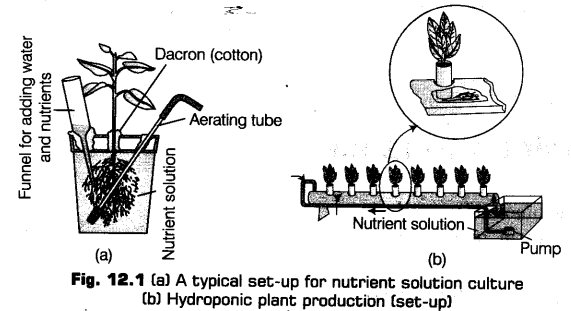
On conducting a series of experiments, in which roots of the plants were immersed in nutrient solution by eliminating or adding an element in varied concentration. From this, mineral nutrition suitable for the growth of the plant was obtained.
Result Hydroponic revealed the identification of essential elements for plant growth and also helps in discovering their deficiency symptoms.
Conditions Necessary in Hydroponics to Achieve Optimum Growth
(a) The concentration of mineral nutrients must be constantly maintained.
(b) The solution must be aerated adequately for proper growth and activities of roots.
(c) pH of the solution is checked from time to time and corrections are made if necessary.
Uses of Hydroponics
(a) This technique has been successfully employed for commercial production of vegetables (like tomato, seedless cucumber, lettuce, etc) and also in knowing the toxicity of plant (if element is present in high amount).
(b) Useful in determining the essential role of nutrients or mineral elements for the metabolism of plant.
Essential Mineral Nutrients (Elements)
Essential elements are those which have structural or physiological role and without which plants are unable to complete their life cycle.
Plants can absorb most of the minerals present in the soil. More than sixty minerals present in soil have been recorded essential in plants out of 105 discovered so far.
Apart from all these elements some plants accumulate other elements also, that are heavy and toxic in nature such as silicon, cobalt, selenium and gold. Some other plants growing near nuclear test sites also accumulate radioactive elements like strontium.
However, techniques had developed in order to detect the mineral even at very low concentration,
i. e., 10 g/mL. Thus, all the elements found in plants are not essential for plant growth and development.
Criteria for Essentiality
In order.to determine whether the particular element is essential or non-essential, the element must follow the criteria for essentiality given below
(i) The element must be able to support normal growth and reproduction, i.e., in the absence of a particular element, the plant becomes unable to complete its normal life cycle.
(ii) Requirement of the particular element in appropriate amount must be specific and it should not be replaced by any other element, i.e., if the deficiency of one element occurs, it should not be fulfilled by the addition of some other element.
(iii) The element must be involved directly in the functioning and metabolism of the plant.
Classification of Essential Mineral Elements
Essential elements occur in different proportions in plants. On the basis of the above mentioned criteria of essentiality some elements have been found to be absolutely essential for the normal and better growth, metabolism and development of plants.
These elements have been grouped into following two categories based on quantitative requirements
i. Macronutrients
These are the elements generally found in plant tissues in large amounts (in excess of around 10 m mole kg-1 or 10 mg per gram of dry matter) and also called major elements. These elements are generally involved in the synthesis of organic molecules and development of osmotic potential.
These are carbon, hydrogen, oxygen, nitrogen, phosphorus, sulphur, potassium, calcium and magnesium. Out of all these elements, carbon, hydrogen and oxygen are obtained from CO2 and H2O while, the others are obtained from the soil.
ii. Micronutrients
These are the elements generally found in traces (very small amount only, i.e., less than 10 m mol kg-1 or less than 0.1 mg per gram of dry matter). Micronutrients are generally eight in number and include iron, manganese, copper, molybdenum, zinc, boron, chlorine and nickel. These are mostly involved in the functioning of enzymes as co-factors or activators of metals.
Differences between Macronutrients and Micronutrients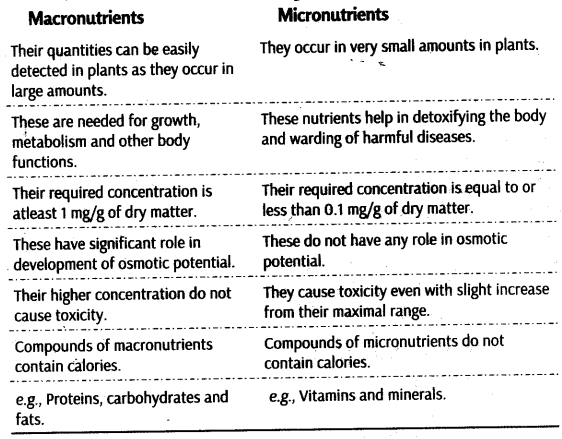
Based on the diverse functions of essential elements, these are also categorised into four other categories given below
(i) As the constituents of biomolecules These are the essential components of biomolecules. Hence, known as the structural elements of cells, e.g., carbon, hydrogen, oxygen and nitrogen.
(ii) As the energy related chemical compounds Some elements also function in providing energy to the cell, e.g., Phosphorus is a component of ATP which functions as an energy currency of all the living systems, while magnesium is a component of chlorophyll, which is involved in the conversion of light energy into chemical energy.
(iii) As the part of enzymes showing catalytic effects Many of the essential elements are required in the form of cofactors by enzymes. They function as the activator or inhibitor of enzymes, e.g., Mg2+ acts as an activator of several enzymes in both photosynthesis (e.g., Ribulose biphosphate (RuBP) carboxylase, phosphoenol pyruvate (PEP) carboxylase) and respiration (e.g., hexokinase and phosphoffuctokinase).
While Zn2+ acts as an activator of alcohol dehydrogenase and Mo of nitrogenase during the course of fixation of nitrogen.
(iv) As the elements altering osmotic potential Some of the essential elements also alter the osmotic potential. Most of the osmotic potential of cell is due to the inorganic salts.
Osmotic potential is necessary for absorption of water and maintaining turgidity of cell.
Role of Macro and Micronutrients
The essential elements perform several important rot, most important of them are given below
1. Regulation of permeability of cell membrane.
2. Maintenance of osmotic potential of cell sap.
3. Some of them takes part in an electron transport system.
4. Others function in buffering action, enzymatic activity and also function as a major constituent of macromolecules and co-enzymes.
Macronutrients
Various macronutrients with their sources, regions and numerous junctions are given below
i. Nitrogen (N)
It is a major constituent of amino acids, proteins, nucleic acids, hormones, vitamins, etc. It was the first macronutrient to be discovered and is required in very large amount by plants.
Nitrogen is not utilised by plants directly as such. It is mainly absorbed in the form of nitrates (NO3), while others absorb, it in the form of nitrites (NO2) or as ammonium ion (NH4–)
Region It is usually required by all parts of plants, mainly the meristematic tissues, and by all the cells, which are metabolically active in nature
Functions Its main function is in growth, metabolic activities and also serves as enzymes in photosynthesis, etc.
Carbon, Hydrogen and Oxygen
These are although not considered as mineral elements still, they have an essential role in growth of plants. Together they constitute about 94% of the total dry weight of the plant. All of these are also important part of carbohydrates, fats and proteins.
C, H, O and N are all together called structural elements because they are the components of biomolecules of the cell.
ii. Phosphorus (P)
Most soils are phosphorus deficient. It is present in plants as both organic and inorganic forms. Organic form of phosphorus is not absorbed by plant as such, instead, it is either taken from the solid or the solution phase of soil. It is a constituent of certain proteins, all nucleic acid and cell membranes.
The decomposition organic form results into an inorganic form of phosphorus, which is then utilised by the plants.
It is generally absorbed by roots from soil in the form of phosphate ions (either as H2PO4– or HPO42- ).
Regioii It is required in all meristems or young tissues and in the regions of developing fruits and seeds.
It generally gets withdrawn from the older tissues which becomes metabolically less active.
Functions It is mainly involved in phosphorylation reactions and also has its importance in energy transfer reactions.
Phosphorus is also present in high energy biomolecules such as adenosine triphosphate (ATP) and guanosine triphosphate (GTP). It also has its major role in ripening of grains and fruits.
iii. Potassium (K)
It does not acts as a constituent of any organic substance, so potassium (K+) is available to plants in its inorganic form such as potassium sulphate, potassium nitrate, etc. It is one of the major constituents of protoplasm.
Region It is found in all tissues of plants that has the property of differentiating themselves like meristematic tissues, bud, leaves and root tips.
Its amount is equal in whole plant except in seeds where it is found in lesser quantity.
Functions It helps in maintaining anion-cation balance in cells and is also involved in the synthesis of proteins. It has its major role in opening and closing of stomata, in activation of enzymes and also helps in maintaining the turgidity of cells.
iv. Calcium (Ca)
It is an element which is always found in green plants and is absorbed by them in the form of calcium ions (Ca2+) from the soil.
Region It is needed much in differentiating and meristematic tissues. It gets accumulated mosdy in the older leaves.
Functions It functions in the synthesis of pectin (calcium pectate) found in middle lamella of the cell wall during cell division. It is also involved in the organisation of mitotic spindle. It activates certain enzymes and plays an important role in the regulation of cellular activities.
v. Magnesium (Mg)
It is the major component of ring structure of chlorophyll, without which the formation of chlorophyll does not takes place. It is absorbed by the plants in the form of a divalent magnesium ion (Mg2+) from the soil.
During rainy season magnesium is leached out from the soil due to which its amount become deficient in plants.
Region It is required in growing areas of roots, stems, seeds.
Functions It helps in the activation of enzymes of photosynthesis and respiration, in the formation of chlorophylls, carotenoids and nucleic acids (DNA and RNA) and to maintain the structure of ribosome.
vi. Sulphur (S)
It is found usually in the complex proteins of plants.
The most abundant reservoir of sulphur in soil is in the organic form, such as lipids, amino acids, proteins, etc.
It is absorbed by the plants in the form of sulphate ions (SO42-) from mineral fraction of soil.
Region It is required mostly in young leaves and meristems.
Functions It acts as a major constituent in amino acids like cysteine and methionine and. also of several co-enzymes, vitamin (like thiamin, biotin, coenzyme-A (Co-A) and ferredoxin).
It is due to the presence of sulphur constituent in Liliaceae family plants like onion, garlic, etc., that they have a characteristic odour.
Micronutrients
Various micronutrients with their sources, regions and numerous functions are given befow
i. Iron (Fe)
It is required in huge amount by plants in comparison to other micronutrients. It occurs in the soil mainly in the form of hydroxides and oxides and is absorbed in the form of ferric ions (Fe3+).
Region It is required by every part of plant but is found abundantly along veins of the leaves.
* Excess amount of iron is stored as ferritin in plants.
Functions It is involved in the transfer of electrons like ferredoxin and cytochromes. Also plays an important role in reactions involving conversion of energy in both photosynthesis and respiration.
i. e., Fe2+ –>Fe3+ helps in the development of chloroplasts, chlorophyll and other pigments.
a. Manganese (Mn)
The oxides of manganese are common in soil. However, its highly oxidised form is not available to plants.
It is absorbed by the plants in the form of manganous ions (Mn2+).
Region It is required in leayes and seeds of plant.
Functions It is helpful is activating many enzymes that are involved in photosynthesis, respiration and nitrogen metabolism. It also functions majorly in photolysis of water in order to liberate oxygen during the process of photosynthesis.
iii. Zinc (Zn)
Zinc is absorbed in the form of Zn2+ions. Zinc occurs in ferromagnesium minerals. These minerals are weathered in order to liberate bivalent form of Zn2+ .
It is considered to be more soluble in soil than other heavy metals.
Region Zinc is required in every part of the plant. Functions It helps in activation of various enzymes like carboxylases, oxidases, dehydrogenases, kinases, etc., and also in the formation of chlorophyll pigment. It is also needed in the synthesis of auxin.
iv. Copper (Cu)
It is found in very low amount in soils. It is absorbed as cupric ions (Cu2+). It acts as a component or activator of plastocyanin, cytochrome oxidase and many other enzymes.
Region It is also required in every part of plants like zinc.
Functions Like iron, it is also involved with enzymes that are required in redox reactions.
It can also oxidise in the reversible direction, i.e., from Cu to Cu2:
v. Boron (B)
It is one of the most essential element for the growth of nearly all plants, e.g., Tomafo, lemon, mustard, cotton, etc.
It is absorbed by the plants in the form of BO33- or B4O72- ions from the soil.
Region It is required mostly by leaves and seeds.
Functions It is essential in transportation of carbohydrate through phloem tissues. Boron is needed for uptake and utilisation of calcium, in the germination of pollen and root nodulation elongation of cell differentiation and carbohydrate translocation.
If pH increases, availability of boron to plant gets decreases.
vi. Molybdenum (Mo)
The amount of this element in soil vary widely. Plants obtain it in the form of molybdate ions (MoO2+).
Region It is required everywhere in plants but mostly utilised by roots.
Functions It is an essential component of several enzymes including two enzymes involved in metabolism of nitrogen, i.e., nitrogenase and nitrate reductase. It also has role in reduction of nitrate to nitrite during the synthesis of amino acids.
vii. Chlorine (Cl)
It is abundant in nature. lt is absorbed by the plants in the form of chloride ions (Cl ).
Region It is also required everywhere like zinc and copper. Functions It helps in transfer of electrons from H2O to photosystem-II in photosynthesis (water splitting reaction in order to evolve O2). It is also helpful in determining the concentration of solute with Na+ and K+. It seems to be essential in balancing cationic and anionic ratio in cells.
Nickel (A micronutrient)
It is also added as a micronutrient recently. It is found to be very mobile in plants and is absorbed by the plant in the form of Ni2+ ions.
Region It is required in whole plant.
Function It acts as an essential part of enzyme urease which hydrolyse urea—> CO2 + NH4.
Deficiency symptoms Plant produces non-viable seeds upto 3rd generation due to its absence and may also leads to necrotic spots on leaf tips.
Deficiency Symptoms of Essential Elements
The deficiency symptoms vary from element to element and they tend to disappear when the particular deficient mineral nutrient is provided to the plant.
Whenever the supply of an essential element becomes limited, growth of the plant gets retarded.
However, if the deprivation of the same nutrient continue for a long period of time, it may eventually leads to the death of the plant.
(i) Critical Concentration is limited concentration of the essential element below which the growth of plant get reduced, retarded or stops.
Each essential element plays a vital role in structural and functional composition of plant. Thus, in the absence of any particular element, plants shows various morphologicial changes, which are indicative of certain element deficiencies and are called deficiency symptoms.
The plant parts show symptoms of deficiency depending on the mobility of that element in the plant.
Accordingly, these can also be divided as
(i) Mobile elements When the elements are actively mobile within the plants, the symptoms tend to appear first in older leaves and tissues. It is because the elements get mobilised from senescing regions to young tissues.
For example, deficiency symptoms of N, K and Mg are visible in the senescent leaves first because these elements are actively mobile.
In the older leaves, biomolecules containing these elements are broken down, making these elements available for mobilising to younger leaves.
(ii) Immobile elements When the elements are immobile within the plants, the symptoms appear first in young leaves and tissues, because the elements are not transported out of the mature organs.
For example, Elements like sulphur and calcium are not released out easily from the plant as they act as an important part of the structural component of the cell.
This aspect (mobility of elements) of mineral nutrition in plants play a very vital role in agriculture and horticulture.
Some Major Deficiencies in Plants
Various kinds of deficiency symptoms shown by the plants are given below
(i) Necrosis It is the phenomenon, which leads to the death of tissues, cell or organ mainly leaf tissue, while it is still a part of the living plant.
It is caused due to the deficiency of elements like Ca, Mg, Cu, K, etc.
(ii) Chlorosis It is the loss of chlorophyll which leads to the yellowing of leaves. This symptom is caused by the deficiency of elements like N, K, Mg, S, Fe, Mn, Zn and Mo in plants.
(iii) Inhibition of cell division It occurs due to the lack or low levels of elements like N, S, Mo, K, etc.
(iv) Delay flowering Deficiency of elements, like N, S, Mo leads to delay in flowering of plants.
(v) Stunted plant growth If the low availability of element occurs, it may leads to inhibition of growth in plant and may eventually lead to the dwarfing (shortening) of whole plant, e.g.y N, K, Ca, S, Zn, B, Mo and Cl.
(vi) Premature fall of leaves and buds It is another type of deficiency symptom that occurs due to the lack of different minerals like P, Mg, Cu, etc.
Differences between Necrosis and Chlorosis Necrosis Chlorosis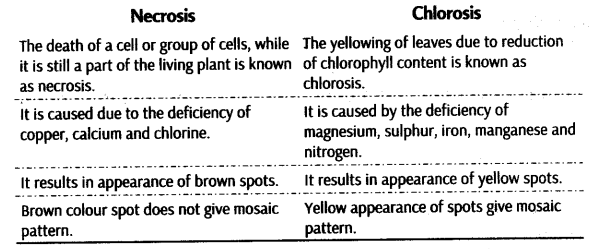
Toxicity of Micronutrients
A moderate decrease of micronutrients cause deficiency symptoms, while a moderate increase leads to toxicity. Thus, whenever the concentration of mineral ion in tissues reduces the dry weight by about 10%, it is considered to be toxic.
The level of toxicity varies for different micronutrients from plant to plant. When the toxicity of element increases to certain level it may also inhibit the uptake of another element. e.g., the prominent symptom of manganese toxicity is the appearance of brown spots surrounded by chlorotic veins.
It is important to know that manganese competes with iron and magnesium for uptake and with magnesium for binding with enzymes. Mangaqcse also plays role to inhibit the calcium translocation in shoot apex.
Therefore, presence of manganese in excess amount may, induce deficiencies of iron, magnesium and calcium.
Topic 2 Mechanism of Absorption and Nitrogen Metabolism
Mineral Absorption
Absorption of mineral salts by plants from the soil occurs through the roots mainly from the root hairs and the zones of absorption. Hence, plants absorb the minerals from the soil for their translocation to other parts of the body through stream of xylem.
Minerals are not absorbed as such by the plants instead they are absorbed in their ionic forms.
For example, chlorine is not absorbed as such by the plant insteadly it gets accumulated in the form of chloride ions.
Mineral absorption by plants is done by two different phases
(i) Initial Phase (Passive transport) It is the pathway by which water or ions present in the free space or outer space of cells are up taken by roots of plants by taking apoplast pathway (avoid entry into cellular membranes and cytoplasm).
In this phase, the plant absorbs mineral very rapidly and does not need any metabolic energy in the form of ATP. Thus, it is called passive process. The passive movement of ions occurt through ion-channels and the transmembrane proteins that functions as selective pores into apoplast.
(ii) Metabolic Phase (Active transport) It is the pathway which is dependent on metabolic energy in the form of ATP for the uptake of mineral ions by the roots into the inner spaces i.e., symplast of the cell. Hence, is called active process.
The movement of ions from cell-to-cell is called flux. It can be further divided into two main types
(i) Influx (inward movement of ions into the cells)
(ii) Efflux (outward movement of ions out of the cells)
Differences between Active and Passive Absorption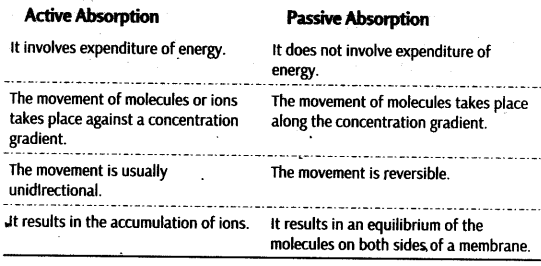
Translocation of Solutes
After absorption the mineral salts passes readily inward with the transport of water. The translocation of mineral elements to different parts of the body is done through tracheary elements of the xylem to reach upwardly to the leaves and other parts (ascent of sap). It is done through the plants by the transpirational pull.
Note:
* The upward movement of water through stem is called ascent of sap. It occurs mainly through xylem.
* Minerals pass through xylem (not phloem) is proved by Stout and Hoaglan in 1939.
Soil as Reservoir of Essential Elements
Soil itself acts as a mineral nutrient reservoir in natural conditions, but it is not essential for the growth of plant. The majority of nutrients studied as far are essential for the growth and development of plants. These elements become available to the roots of plants by the weathering and breakdown of rocks.
Due to which the soil become enriched with ions and inorganic salts which are ultimately taken up by the plants itself.
Functions of Soil
Following functions are being performed by the soil
(i) Soil supplies minerals to plant and also harbours nitrogen fixing bacteria and other microbes.
(ii) It contains wide variety of substances essential for plant.
(iii) It holds water and supplies air to the roots.
(iv) It also acts as a matrix that helps in stabilisation of plant.
Fertilisers, are the organic or inorganic materials that are added to soil to supply one or more nutrients which are essential to the growth of plants. Since, deficiency of essential mineral affects yields of crop thus, both macro (N, P, K, S, etc) and micronutrients (Cu, Fe, Zn, Ni, M, B, -etc) acts as component of fertiliser and applied as per requirement.
Metabolism of Nitrogen
Nitrogen exists as two nitrogen atoms joined by a very strong triple covalent bond ( = )Nitrogen is
needed by plants for the production of proteins, nucleic acids (DNA and RNA), chlorophyll and many other vitamins. It is also the most prevelant element apart from carbon, hydrogen and oxygen.
It is absorbed as an inorganic compound which is changed into its organic form by plants and certain microbes.
The ultimate source of nitrogen is the nitrogen gas present in the atmosphere. As nitrogen is limited in nature, plants compete with microbes for available nitrogen in the soil. Thus, nitrogen acts as a limiting nutrient for both natural and agricultural ecosystems.
Nitrogen Cycle
It is the process of cycle of events by which free atmospheric nitrogen is converted into its various chemical forms.
The nitrogen cycle consists of four important processes, i.e., nitrogen-fixation, ammonification, nitrification and denitrification.
1.Nitrogen-Fixation
In this process, atmospheric nitrogen is fixed which is to be used by the plants. In this step, the molecular nitrogen .
2. converted into inorganic nitrogenous compounds like nitrate, nitrite and ammonia.
Nitrogen fixation is of two types
(i) Physical nitrogen-fixation
(ii) Biological nitrogen-fixation
i. Physical Nitrogen-Fixation
It is the conversion of N2 to inorganic nitrogenous compounds without the involvement of microorganisms.
Fixation occurs in nature by lightening and ultra violet radiations by which nitrogen gets converted into its oxides (as NO, NO2, N2O etc) on combining with O2. These oxides also gets generated by forest fires, industrial combustions and by. some power generating stations.
ii. Biological Nitrogen-Fixation
The conversion of atmospheric nitrogen into inorganic nitrogenous compounds (nitrate, nitrite and ammonia) through microorganisms (bacteria, cyanobacteria, etc) are called biological nitrogen-fixation.
As only few organisms utilise atmospheric nirogen, certain prokaryotes are capable of fixing nitrogen. The prokaryotic organism that reduce nitrogen has an enzyme called nitrogenase such microbes are called 2 fixers.
NEN Nitrogenas
The organisms that fix nitrogen can be of two types
(a) Asymbiotic or Free living bacteria These are bacteria that are not present in close relationship with another bacteria or other organisms in order to convert nitrogen into ammonia, e.g., number of cyanobacteria like Anabeana and Nostoc.
The free living bacteria can also further divided as
* Free living aerobic These include microbes like Azotobacter and Beijemickia.
* Free living anaerobic These include microbes like Rhodospirillum and Clostridium.
(b) Symbiotic bacteria These are bacteria the fixes nitrogen by forming close associations with each other or with another organism, e.g., relationship between Rhizobium bacteria with legumes and
mycorrhizae with vascular plants, etc.
Frankia and Rhizobium, both are unable to fix nitrogen when present as free living (aerobes) in soil. But when present as symbionts they become anaerobes and are able to fix atmospheric nitrogen.
Symbiotic Biological Nitrogen-Fixation
The process of symbiosis involves two organisms living together in different associations. Several types of biological nitrogen fixing associations are known. The most familiar one is the relationship of Rhizobium with the roots of several legumes belonging to class-Leguminosae like sweet pea, lentils, garden pea, alfalfa, sweet clover, broad bean, clover beans, etc.
They get associated mosdy on the root hair cells, the root hair curl and the bacteria invade it. An infection thread is produced carrying the bacteria into the cortex where they initiate root nodule formation. Root nodules are small, irregular outgrowth on the roots.
They are internally pinkish in colour due to the presence of leguminous haemoglobin or leghaemoglobin (similar to the haemoglobin, the red pigment present in human blood).
Symbiotic nitrogen fixing bacteria are also known to occur in the roots of certain non-leguminous plants (both angiosperms and gymnosperms) i.e.,Alnus and Cycas respectively.
Insectivorous Plants
The carnivorous angiosperms (insectivorous plants) are autotrophic in nature. But, the strange thing about these plants is they behave as heterotrophic organisms for supplementing their nitrogen requirements by trapping insects and other small animals enzymatically and digesting them.
They usually grow in water logged soil or swamps where the soil is deficient in nitrogen supply. Thus, these plants fulfil their need from insects and small animals by trapping them through the leaves, e.g., Pitcher plant (Nepenthes), Venus fly trap, sundew, water flewtrap etc.
Nodule Formation
The process of formation of nodules is a series of multiple interactions that takes place between Rhizobium bacterium and the root system of legume plant (host).
During the process, bacteria initially grow in soil near the roots of higher plants. They are unable to fix nitrogen there:, but after coming in contact with the roots of leguminous plants, they interact chemically and enter into roots through root hairs.
The process of nodule formation is as follows
(i) Rhizobium multiply and colonize itself to the surrounding of the roots of host plant where it gets physically attached to the epidermal root hair cells.
(ii) After attachment, the root hair gets curled up at the tip due to which bacteria invade the root hair.
(iii) The enzymes from the bacteria degrade the parts of root hair cell wall which produces a thread-like structure called infection thread.
(iv) The bacteria invade the infection thread and reaches upto the inner cortex of the root.
(v) The bacteria after reaching cortex (mainly tetraploid cells) stimulate the initiation of formation of nodule.
(vi) Bacteria enlarges in size and become bacteroid (rod-shaped) thus, leaving the infection thread and enter the cells, i.e., inner cortical and pericycle cells to divide.
(vii) This growth and division of pericycle and . cortical cells leads to the formation of a knob-like structure called mature root nodule.
(viii) The nodule, thus formed after division is finally responsible for the direct vascular connection with the host for the exchange of nutrients.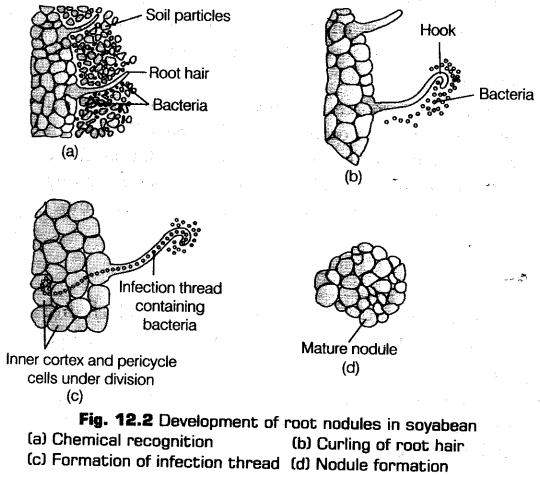
Mature Nodule
The mature nodule thus, formed after a series of events (as discussed above) and chemical changes contains all the essential biochemical components i.e., leghaemoglobin and the enzyme nitrogenase. The enzyme nitrogenase catalyses the conversion of free nitrogen into ammonium, (first stable product).
The enzyme nitrogenase has two subunits, i.e., Fe protein (non-heme iron protein) and Mo-Fe protein (iron molybde-num protein).
The Fe protein component reacts with ATP and reduces Mo-Fe protein which then reduces 2 to ammonia.
Nitrogenase enzyme, cannot function in aerobic conditions as it is highly sensitive to molecular oxygen (O2). Thus, for its activity it requires anaerobic conditions. Hence, in order to protect this enzyme from oxygen, the nodules produce a substance known as leg-haemoglobin (oxygen scavenger). Nitrogenase is not active when these microbes lives in aerobic
conditions, i.e., free-living but becomes active or functional in anaerobic conditions during events of nitrogen fixation.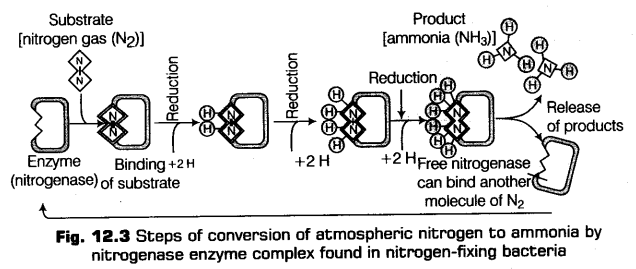
Note:
* Winograd Sky (I89l) discovered biological nitrogen fixation.
* The reaction involving NH3– synthesis by nitrogenase enzyme requires a very high input of energy (8 ATP for each NH3 produced). The energy required, thus, is obtained from the respiration of the host cells.
2. Ammonification
In next step, organic matter (proteins and nucleic acids) of the dead remains are decomposed in order to produce ammonia (NH3) by microorganisms (like Actinomycetes, Clostridium etc.). Out of the ammonia product, some of the ammonia gets volatilised and re-enters into the atmosphere, while most of it undergo the process of nitrification by soil bacteria.
Fate of Ammonia
Nitrogen assimilation results in the formation of ammonia which is further used for the synthesis of amino acid. Most of the plants can assimilate both nitrate and ammonium ions (NH4) (the ammonium ions are formed by the protonation of ammonia at physiological pH). Ammonium ions are toxic to plants and cannot accumulate in them.
Thus, these 4 are used in the synthesis of amino acids in plants by following two methods
(i) Reductive animation During this process, the ammonia reacts with a-ketoglutaric acid (organic acid) and forms an amino acid, i.e., glutamic acid.
(ii) Transamination It is the transfer of amino group (—NH2) of one amino acid to keto group (C = O) of another keto acid. The enzyme responsible for this is transaminase or aminotransferase.
Glutamic acid is the main amino acid involved in the synthesis of other amino acids through transamination.
Glutamic acid is mainly responsible for making the transfer of amino group to keto group possible.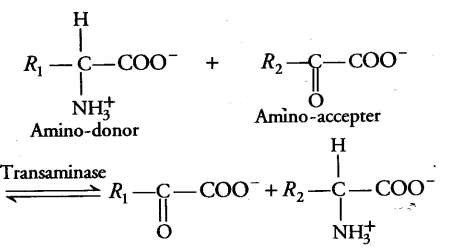
Amides
These are generally formed by the combination of amino acids and ammonia. Their formation takes place by replacement of hydroxyl ions of amino acid by NH2 ion.
The two most common amides formed in plants are aspargine and glutamine formed by the addition of another amino group to amino acids i. e., aspartic acid and glutamic acid respectively,
Uses of Amides
(i) Both of the amides, i.e., aspargine and glutamine acts as metabolic reservoirs. They get accumulated in the tissue of healthy plants at the time of assimilation of ammonia (if assimilation occurs in excess amount).
(ii) They are translocated to other parts of plant through xylem vessels in the form of nitrogen rich compounds because they contain more nitrogen than the amino acids.
In some plants ureides acts as transporters of fixed nitrogen along with transpiration stream (e.g., soyabean). These also have high nitrogen to carbon ratio.
3. Nitrification
It is the process in which ammonia produced by the degradation of manures may not be available to plants. So, it is first oxidised to nitrite by the soil bacterium Nitrosomonas or Nitrococcus. This nitrite is then further oxidised to nitrate by another soil bacterium i.e., Nitrobacter. The bacteria which helps in the process of nitrification are collectively known as chemoautotrophs.
The nitrate thus, formed are absorbed by plants and then transported to the leaves where it gets reduced to ammonia that finally forms amino-group of amino acids.
4. Denitrification
It is the process in which the nitrate present in the soil is reduced back to free nitrogen (N2). The process of denitrification is carried out by denitrifying bacteria (like Thiobacillus denitrificans, Pseudomonas denitrificans etc).
Denitrifying bacteria utilises nitrate and nitrite ions as electron acceptors in place of oxygen.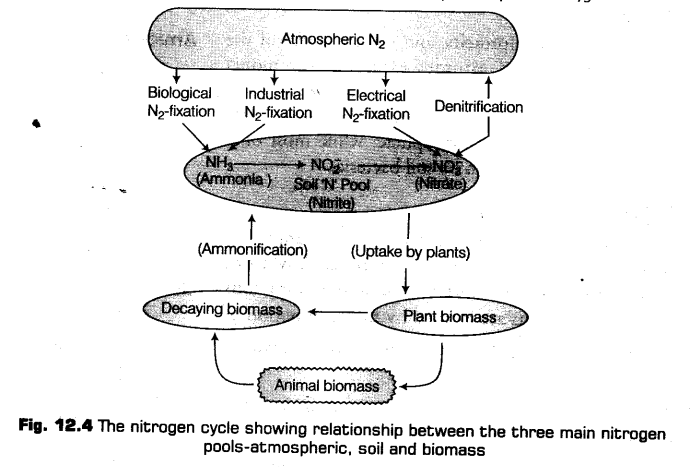
CBSE Class 11 Biology Chapter-12 Important Questions
1 Marks Questions
1.Name a soil bacteria which is capable of converting ammonia to nitrates.
Ans . Nitrosomonas.
2.Which macronutrient is essential for synthesis of auxin.
Ans. Zinc
3.What do you mean by “chlorosis”?
Ans .Lack of development of chlorophyll in the leaves.
4.Name any two elements having toxic effect on protoplasm?
Ans. Lead, mercury and arsenic.
5.What is hydroponics?
Ans. Plant growth in nutrient rich liquid culture medium.
6.Give the function of enzyme nitrate reductase.
Ans. It reduces nitrate ions to ammonia.
7.Name essential components of biomolecules.
Ans. C, H, O and N.
8.Name the enzyme that can reduce nitrogen to ammonia.
Ans. Nitrogenase enzyme.
9.What are micronutrients?
Ans. Elements which are required by the plants in very small or trace quantities are termed as micronutrients for eg; zinc copper, etc.
10.Name one symbiotic nitrogen-fixing bacteria.
Ans. Rhizobium
11.Give two examples of photosynthetic micro-organisms, which also fix atmospheric nitrogen.
Ans. Anabaena, Nostoc.
12.Name two organisms each which fix nitrogen asymbiotically and symbiotically.
Ans. Asymbiotically – Azotobacter, Bacillus polymyxa.
Symbiotically – Rhizobium, Anabaena.
13. Which substance imparts pink colour to the root nodule of a leguminous plant and also mention its role ?
Ans. Leghemoglobin. It is an oxygen scavenger, which protects the enzyme nitrogenase.
14. What is the term used for mineral deficiency symptom in plants in which leaves become yellow in different pattern ?
Ans. Necrosis.
15. Define hydroponics.
Ans. The technique of growing plants in a nutrient solution without soil is called hydroponics.
2 Marks Questions
1.A farmer adds azotobacter culture to the soil before sowing maize. How does it increase the yield of maize?
Ans. Azotobacter provides nitrogen fixing bacteria which converts free nitrogen into nitrous and nitrites. It increases soil fertility. So it increases yield of maize.
2.Name the pigment found in root nodules of legumes. What is its function?
Ans. Root nodules of leguminons plants contain pigment leghaemglobin. Its function is to protect nitrogenase from oxygen. Hence called ‘oxygen scavenger’.
3.What is hydroponics? Mention its uses?
Ans. Hydroponics is the cultivation of plants in the nutrient solution by placing their rooted part in nutrient solution. By hydroponics or water culture experiment, essentiality of an element for plant growth can be determined by exceeding a particular element in culture solution and by observing the symptoms caused by its deficiency.
4.What is balanced nutrient solution?
Ans. Balanced nutrient solution or balanced salt solution is prepared by dissolving definite proportions of salts in distilled water needed for normal plant growth. The plants growing in these solutions survive munch longer as they get all essential as well as the trace elements from medium.
5.What is nitrification? Name any two nitrifying bacteria in soil?
Ans. Nitrification is the process of conversion of ammonia into nitrites. It involves two steps:-
(i) Ammonium ions are oxidized into nitrates by the bacteria like Nitrosomonas and Nitrosococcus.
(ii) Nitrites are converted into nitrates by the bacteria like Nitrobacter.
6.In what form is magnesium absorbed by plants from the soil. Given two functions of magnesium in plants & its deficiency symptoms.
Ans. Magnesium is absorbed by the plants from the soil in the form of divalent Mg2+.
Functions –
1) Synthesis of DNA and RNA.
2) It activates enzymes in respiration and photosynthesis.
Deficiency symptoms –
1) Chlorosis between the leaf veins.
2) Premature leaf abscission.
7.List the four broad groups of essential elements.
Ans.
| Type | Examples and its Role | |
| 1. | Components of bimolecules | C,H,O,N is a component of nucleic acids and proteins. |
| 2. | Components of energy related chemical compounds. | Mg. P. P is a constituent of ATP molecule. |
| 3. | Activate or Inhibit enzymes. | Mg2+, Zn2+, Mo. Mo is activator of nitrogenase in N2 metabolism. |
| 4. | Alter osmotic potential of a cell. | Potassium. It is a essential. In opening of closing of stomata leaves. |
8.How is hydroponics useful?
Ans. Hydroponics is essential to know the following-
(i) Essentiality of mineral element.
(ii) Deficiency symptom due to non – availability of specific nutrient.
(iii) Toxicity to plant if element is present is excess.
(iv) Role of essential elements is metabolism of a plant.
9.What is mineral nutrition? Name one essential element that is a component of energy – related chemical compounds.
Ans. Plants require mineral nutrients for their growth and development which do not occur in the plant body in Free State. The utilization of there elements by the plants for its growth and development is called mineral nutrition. Mg in chlorophyll is essential component of energy-related chemical compound.
10. Name the following:
(a) Bactoria which converts ammonia into nitrite.
(b) Bacteria which oxidises nitrite into nitrate.
Ans. (i) Nitrifying Bacteria – Nitrosomonas.
(ii) Nitrifying Bacteria – Nitrobacter.
3 Marks Questions
1.What do you understand by “Donnan Equilibrium?
Ans. This theory explains that the passive accumulation of ion that are fixed on non-diffusible, against an ecp gradient. A membrane that separates a cell from the external medium and allows exchange of some ions and not the other. On the inner side of this membrane are anions (fixed & non-diffusible). The membrane becomes impermeable to these anions. In such condition (for equilibrium) mobile cations are needed to balance the negative charges of the anions. According to it Donnan equilibrium is reached, if the product of anions and cations is the internal solution becomes equal to the product of anions and cations in the external solution.
[Ci+] [Ai–] = [Co+] [Ao–]
Where Ci+ = cations inside
Ai– = Anions in side
Co+ = Cations outside
Ao– = Anions outside.
2.What are essential mineral elements?
Ans. Mineral elements found in soil which may enter plants through the roots. More than 60 elements of 105 discovered so far occur in different plants. Some accumulate selenium but some others gold. Some plants growing near nuclear test sites takes up radioactive strontium.
3.Differentiate between active & passive absorption.
Ans.
| Active Absorption | Passive Absorption | |
| 1. | Absorption of minerals is against the concentration gradient. | Absorption of minerals is along the concentration gradient by simple diffusion. |
| 2. | Energy is utilized for absorption. | Energy is not utilized for absorption |
| 3. | It is fast. | It is slow. |
| 4. | It is unidirectional. | It may be bidirectional. |
| 5. | It is a biochemical process. | It is a physical process. |
4.List the criteria for essentiality of elements as nutrient in plants.
Ans. Criteria for essentiality of element are fallowing-
1) The element must be absolutely essential for supporting normal growth and reproduction.
2) The requirement are need of the element must be specific and not replaceable by another element.
3) An element should be directly involved in the metabolism of the plant.
5.Describe the process of nitrogen fixation in plants. Mention the site where this process actually occur is such plants.
Ans. Nitrogen fixation occurs in nodules in legume plants is gram and arhar. They act as sites for it. The legume plants like pea, gram show symbiosis or mutualism with bacterium, Rhizobium leguminasauram. Nitrogen fixation occurs with the help of enzymes nitrogenase & leghaemoglobin. Leghaemoglobin act as O2 scavenges and nitrogenase catalyse the conversion of N2 into NH3
N2 + 8e– + 16ATP + 8H+ → H2 + 2NH3 + 16ADP + 16 Pi
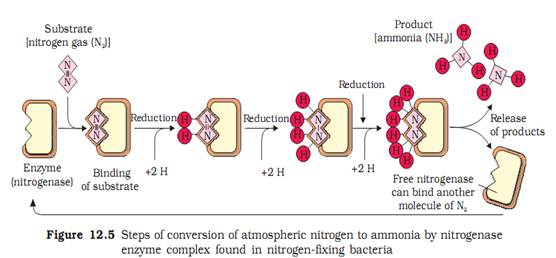
6.Differentiate between apoplast and symplast.
Ans.
| Apoplast (outer space) | Symplast (Inner space) | |
| 1. | It includes cell wall and intercellular space. | It includes the cytoplasm and vacuole of the cell. |
| 2. | Uptake of ions into space is a passive process and involves no expenditure of energy. | Uptake of ions is an active process and involves expenditure of energy. |
| 3. | Initially, the ions are taken up quickly into outer space into medium. | Uptake of ions occurs slowly from the outer space. |
5 Marks Questions
1.Describe the process of development of root nodules in leguminous plant. Name the oxygen scavenger molecule present in root nodules?
Ans. Mineral elements found in soil which may enter plants through the roots. More than 60 elements of 105 discovered so far occur in different plants. Some accumulate selenium but some others gold. Some plants growing near nuclear test sites takes up radioactive strontium.
Formation of root nodules in a leguminous plant:
1) When a root hair of a leguminous plant comes in contact with Rhizobium, the root hair becomes curled or deformed, due to chemicals secreted by bacterium.
2) At the site of curling or deformation, the bacteria invade the root and multiply within the root hair.
3) Some of the bacteria enlarge to become membrane – bound structures known as bacteroids, which help in spreading infection.
4) An infection thread made of plasma membrane is formed by the host that separates the infected cell from rest of the tissue.
5) Cell division is stimulated in the infected tissue and more bacteria enter the newly formed cells.
Leghaemoglobin (Lb) is the oxygen scavenger found in root nodules of legume plants.
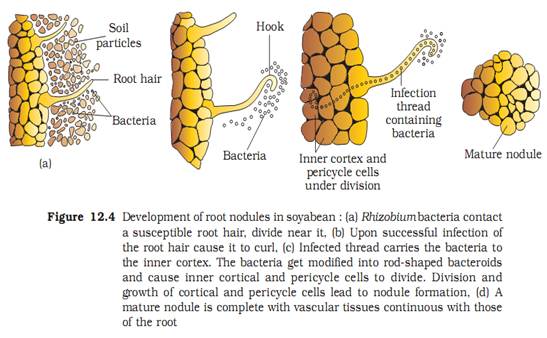
2. Write role of different elements in a plant?
Ans. Some important functions of mineral elements are –
(1) Maintenance of the osmotic pressure in the plant cells – The mineral salts and organic compounds of the cell sap produce necessary osmotic pressure.
(2) Constituents of the plant body – Elements form constitution of the plant body. For ex – Carbon, Hydrogen and oxygen are essential constituents of carbohydrates. Hence, called framework elements. Nitrogen, sulphur and phosphorous are required for synthesis of proteins. Magnesium is important constituent of chlorophyll.
(3) Influence on the PH of the cell sap – They also influence the PH of the cell sap.
(4) They influence the permeability of cytoplasmic membrane – They increase or decrease the permeability of the plasma membrane.
(5) They take part in enzymatic reactions – some elements work as activators while the others works as inhibitors in various enzymatic reactions.
(6) They have balancing functions reactions – some of the minerals balance the effects of the other.
3. Mention the role of micronutrients in plants life?
Ans.
| Micronutrient | Role in plants life | |
| 1. | Boron (B) | Pectin formation in cell wall, Translocation of sugar, Absorption of water. |
| 2. | Molybdenum (Mo) | Reduction of nitrates constituent of nitrate reductases. Activation for photophosphorylation. |
| 3. | Manganese (Mn) | Nitrogen metabolism, chlorophyll synthesis, Activation of enzymes. |
| 4. | Copper (Ca) | Component of enzymes. Component of plastocyanin. |
| 5. | Chloride (Cl) | Transfer of electron. |
| 6. | Zinc (Zn) | Synthesis of auxins. Acts as an activator. |
NCRT TEXTBOOK QUESTIONS SOLVED
1.’All elements that are present in a plant need not be essential to its survival’. Comment.
Soln. Most of the mineral elements present in the soil enter plants through roots but all of these may not be essential for their survival. Some are absorbed and accumulated by plant only because they are present in excess amount. For example plants growing near nuclear test sites take up strontium, even though it is not required by them. Thus, an essential element is that which is necessary for supporting normal growth and reproduction, its requirement must be specific i.e. its deficiency cannot be met by supplying other element and it must be directly involved in the metabolism of plant.
2.Why is purification of water and nutrient salts so important in studies involving mineral nutrition using hydroponics?
Soln.Impure water and salts contain a large number of soluble minerals and impurities. When such water and salts are used as solution culture for growing plants in hydroponics then the impurities will interfere with the experiment and will not give correct result about the essentiality of a mineral element. Therefore, purified water with defined mineral nutrients are used in hydroponics.
3.Explain with examples:macronutrients, micronutrients, beneficial nutrients, toxic elements and essential elements.
Soln. Macronutrients : Those elements which are generally present in plant tissues in large amounts (in excess of 10 mmole Kg-1 of dry matter) and are involved in the synthesis of organic molecules and development of osmotic potential are called macronutrients or macroelement, e.g. carbon, hydrogen, oxygen, nitrogen, sulphur, potassium, calcium and magnesium etc.
Micronutrients : Those elements which are required by plants in’very small amounts (less than 10 mmole Kg-1 of dry matter) are called micronutrients, e.g. iron, zinc, manganese, boron, copper, molybdenum, chlorine and nickel. These elements are mostly involved in the functioning of enzymes as cofactor or metal activators.
Beneficial nutrients : Those elements which are required by higher plants along with the macro and micronutrients are called beneficial nutrients, e.g. cobalt, silicon, sodium and selenium.
Toxic elements : Any mineral element if supplied to plant tissue in such concentration that it reduces the dry weight of tissues by about 10 percent, is called toxic element. e.g. manganese toxicity leads to the appearance of brown spots surrounded by chlorotic veins. Excess of manganese induces deficiency of iron, magnesium and calcium.
Essential elements : Any element required by living organisms to ensure normal gfbwth, development, maintenance, metabolism and causes deficiency symptoms if not supplied to the plant from external medium is called essential element, e.g. C, H, O, N, P, K, S, Mg, Ca, Mn, Cu, Mo, Zn, B, Cl, etc. Potassium plays an important role in opening and closing of stomata, protein synthesis etc. Magnesium is found in chlorophyll and phosphorus in ATP. Mg2+ is an activator for both ribulose bisphosphate carboxylase-oxygenase and phosphsenol pyruvate carboxylase.Zn2+ is an activator of alcohol dehydrogenase and Mo of nitrogenase during nitrogen metabolism.
4.Name at least five different deficiency symptoms in plants. Describe them and correlate them with the concerned mineral deficiency.
Soln.Five different deficiency symptoms in plants are:
(i)Chlorosis – It is the loss of chlorophyll leading to yellowing of leaves. This is caused due to the deficiency of N, K, Mg, S and Fe etc.
(ii)Necrosis – Killing or death of tissue particularly leaf is called necrosis. This is caused due to the deficiency of Ca, Mg, Cu and K etc.
(iii)Whiptail – Degeneration of lamina but not of petiole and midrib , caused by deficiency of molybdenum.
(iv)Die back – It is the killing of shoot apex i.e. stem tip and young leaves. This is caused due to the deficiency of K and Cu.
(v)Little leaf disease – Small sized leaves, caused by zinc deficiency.
5.If a plant shows a symptom which could develop due to deficiency of more than one nutrient, how would you find out experimentally, the real deficient mineral element?
Soln.Deficiency symptoms are first studied by means of pot and culture experiments. Rapidly growing plants which develop characteristic symptoms are used in culture experiments. They are called test (= indicator) plants. They are then grown in soil under test in small pots. The results are compared to know the deficiency elements. Similar tests are performed with selected crops.
6.Why is it that in certain plants deficiency symptoms appear first in younger parts of the plant while in other they do so in mature organs?
Soln. The parts of the plants that show the deficiency symptoms depend on the mobility of the element in the plant. For elements that are actively mobilised within the plants and exported to young developing tissues, the deficiency symptoms tend to appear first in the older tissues. For example, the deficiency symptoms of nitrogen, potassium and magnesium are visible first in the senescent leaves. In older leaves,biomolecules containing these elements are broken down, making these elements available for mobilising to younger leaves. The deficiency symptoms tend to appear first in the young tissues whenever the elements are relatively immobile and are not transported out of the mature organs, for example, elements like sulphur and calcium are a part of the structural component of the cell and hence are not easily released.
7.How are the minerals absorbed by the plants?
Soln. Plants absorb their mineral salt supply from the soil through the roots from the zones of elongation and root hair. The minerals are absorbed as ions which are accumulated by the plants against their concentration in the soil. Plant shows two phases in mineral absorption – initial and metabolic. In the initial phase there is a rapid uptake of ions into outer or free space of the cells (apoplast) that comprises of intercellular spaces and cell walls. Ions absorbed in free space are freely exchangeable, e.g., replacement of unlabelled K+ ions with labelled K+ ions. In the metabolic phase the ions pass into inner space comprising of cytoplasm and vacuole. In the inner space the ions are not freely exchangeable with those of external medium. Entry of ions into outer space is passive absorption as no energy is required for it. Absorption of ions into inner space requires metabolic energy. It is, therefore, an active absorption. Movement of ions into cells is called influx while movement of ions out of the cells is called efflux.
8.What are the conditions necessary for fixation of atmospheric nitrogen by Rhizobiuml What is their role inN2fixation?
Soln.The conditions necessary for nitrogen fixation by Rhizobium are :
(i) Presence of enzyme nitrogenase.
(ii)A protective mechanism for the enzyme nitrogenase against O2
(iii)A non-heme iron protein-ferrodoxin as an electron carrier.
(iv)The hydrogen donating system (viz, pyruvate, hydrogen, sucrose, glucoseetc).
(v) A constant supply of ATP.
(vi)Presence of thiamine pyrophosphate (TPP), coenzyme-A, inorganic phosphate and Mg++ as co-factors.
(vii)Presence of cobalt and molybdenum,
(viii) A carbon compound for trapping
released ammonia.
In the process of biological nitrogen fixation by free living and symbiotic nitrogen fixers, the dinitrogen molecule is reduced step by step to ammonia (NH3) by the addition of pairs of hydrogen atoms. The pyruvic acid mainly serves as an electron donor but in some cases hydrogen, sucrose, glucose, etc., have also been shown to operate. In leguminous plants, the glucose-6-phosphate molecule probably acts as a substrate for donating hydrogen. The overall process occurs in presence of enzyme nitrogenase, which is active in anaerobic condition. The enzyme nitrogenase consists of two sub-units – a non-heme iron protein (or dinitrogen reductase) and an iron molybdenum protein (Mo-Fe protein or dinitrogenase).
The Fe-protein component reacts with ATP and reduces Mo-Fe protein which then converts N2to ammonia. The ammonia is either directly taken by host or is converted to nitrates with the help of nitrifying bacteria (e.g., Nitrosomonas).
9.What are the steps involved in formation of a root nodule?
Soln. Nodule formation involves a sequence of multiple interactions between Rhizobium and roots of the host plant. Main stages in the nodule formation are:
(i) Rhizobia multiply and colonise the surrounding of roots and get attached to epidermal and root hair cells (Figure a).
(ii)The root hair curl and the bacteria invade the root hair.
(iii)An infection thread is produced carrying the bacteria into the inner cortex of the root (Figure b and c).
(iv)The bacteria get modified into rod-shaped bacteroids and cause inner cortical and pericycle cells to divide. Division and growth of cortical and peri cycle cells lead to nodule formation.
(v) The nodule thus formed, establishes a direct vascular connection with the host for exchange of nutrients (Figure d).
(vi)The nodule contains all the necessary biochemical components, such as the enzyme nitrogenase and leghaemoglobin. The enzyme nitrogenase catalyses the conversion of atmospheric nitrogen to ammonia, the first stable product of nitrogen fixation.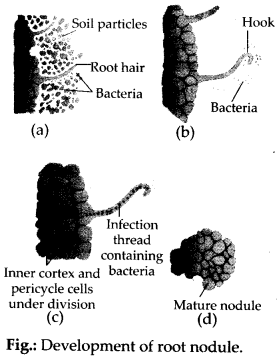
10.Which of the following statements are true?
If false, correct them.
(a) Boron deficiency leads to stout axis.
(b) Every mineral element that is present in a cell is needed by the cell.
(c) Nitrogen as a nutrient element, is highly immobile in plants.
(d) It is very easy to establish the essentiality of micronutrients because they are required only in trace quantities.
Soln. (a) True.
(b) False. Every mineral element that is present in a cell is not needed by the cell.
(c) False. Nitrogen as a nutrient element is highly mobile in plants.
(d) False. It is very difficult to establish the essentiality of micronutrients because they are required only in trace quantities.